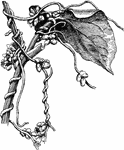Clipart tagged: ‘dodder’

Dodder
"Cuscuta verrucosa. 1. ovary and calyx; 2. section of do.; 3. its fruit; 4. section of a seed of a Cuscuta;…

Dodder
An illustration of Dodder including: 1, flower removed from; 2, Calyx; Ovary cut acrossed; 4, fruit…

Dodder
Illustrated is cuscuta gronovii, one of the most common species of dodder. The plant is twining on its…

Greater Dodder
"Corolla, scales and stamens of, 1. Cuscuta europaea; 2. Cuscuta trifolii." -Lindley, 1853